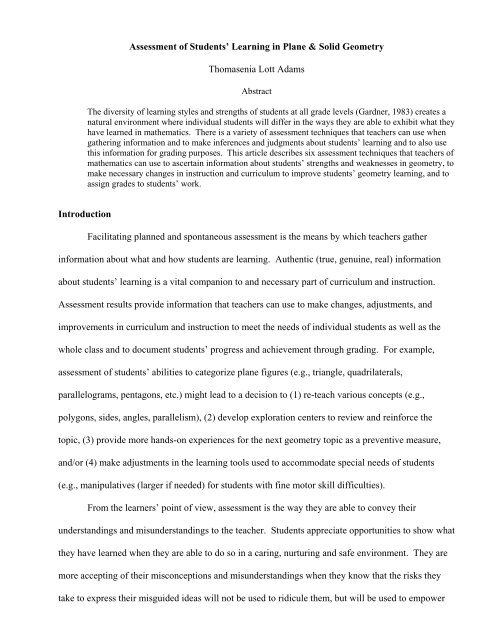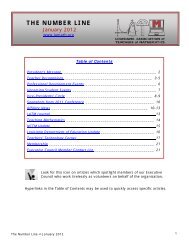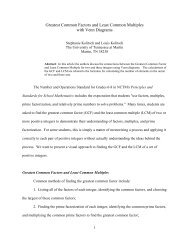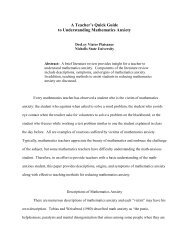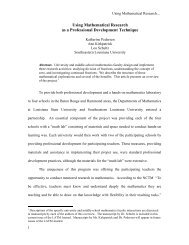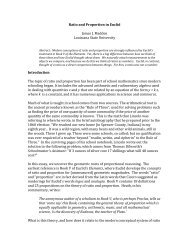Assessment of Students' Learning in Plane & Solid Geometry ...
Assessment of Students' Learning in Plane & Solid Geometry ...
Assessment of Students' Learning in Plane & Solid Geometry ...
Create successful ePaper yourself
Turn your PDF publications into a flip-book with our unique Google optimized e-Paper software.
<strong>Assessment</strong> <strong>of</strong> Students’ <strong>Learn<strong>in</strong>g</strong> <strong>in</strong> <strong>Plane</strong> & <strong>Solid</strong> <strong>Geometry</strong>Thomasenia Lott AdamsAbstractThe diversity <strong>of</strong> learn<strong>in</strong>g styles and strengths <strong>of</strong> students at all grade levels (Gardner, 1983) creates anatural environment where <strong>in</strong>dividual students will differ <strong>in</strong> the ways they are able to exhibit what theyhave learned <strong>in</strong> mathematics. There is a variety <strong>of</strong> assessment techniques that teachers can use whengather<strong>in</strong>g <strong>in</strong>formation and to make <strong>in</strong>ferences and judgments about students’ learn<strong>in</strong>g and to also usethis <strong>in</strong>formation for grad<strong>in</strong>g purposes. This article describes six assessment techniques that teachers <strong>of</strong>mathematics can use to ascerta<strong>in</strong> <strong>in</strong>formation about students’ strengths and weaknesses <strong>in</strong> geometry, tomake necessary changes <strong>in</strong> <strong>in</strong>struction and curriculum to improve students’ geometry learn<strong>in</strong>g, and toassign grades to students’ work.IntroductionFacilitat<strong>in</strong>g planned and spontaneous assessment is the means by which teachers gather<strong>in</strong>formation about what and how students are learn<strong>in</strong>g. Authentic (true, genu<strong>in</strong>e, real) <strong>in</strong>formationabout students’ learn<strong>in</strong>g is a vital companion to and necessary part <strong>of</strong> curriculum and <strong>in</strong>struction.<strong>Assessment</strong> results provide <strong>in</strong>formation that teachers can use to make changes, adjustments, andimprovements <strong>in</strong> curriculum and <strong>in</strong>struction to meet the needs <strong>of</strong> <strong>in</strong>dividual students as well as thewhole class and to document students’ progress and achievement through grad<strong>in</strong>g. For example,assessment <strong>of</strong> students’ abilities to categorize plane figures (e.g., triangle, quadrilaterals,parallelograms, pentagons, etc.) might lead to a decision to (1) re-teach various concepts (e.g.,polygons, sides, angles, parallelism), (2) develop exploration centers to review and re<strong>in</strong>force thetopic, (3) provide more hands-on experiences for the next geometry topic as a preventive measure,and/or (4) make adjustments <strong>in</strong> the learn<strong>in</strong>g tools used to accommodate special needs <strong>of</strong> students(e.g., manipulatives (larger if needed) for students with f<strong>in</strong>e motor skill difficulties).From the learners’ po<strong>in</strong>t <strong>of</strong> view, assessment is the way they are able to convey theirunderstand<strong>in</strong>gs and misunderstand<strong>in</strong>gs to the teacher. Students appreciate opportunities to show whatthey have learned when they are able to do so <strong>in</strong> a car<strong>in</strong>g, nurtur<strong>in</strong>g and safe environment. They aremore accept<strong>in</strong>g <strong>of</strong> their misconceptions and misunderstand<strong>in</strong>gs when they know that the risks theytake to express their misguided ideas will not be used to ridicule them, but will be used to empower
them for the next stage <strong>of</strong> learn<strong>in</strong>g and that their grades are a reflection <strong>of</strong> the empowerment theyhave and still need.<strong>Assessment</strong> and Grad<strong>in</strong>gThe National Council <strong>of</strong> Teachers <strong>of</strong> Mathematics’ <strong>Assessment</strong> Standards for SchoolMathematics (NCTM 1995) provides guidel<strong>in</strong>es for our facilitation <strong>of</strong> assessment <strong>in</strong> all areas <strong>of</strong>school mathematics, one <strong>of</strong> which is geometry. Accord<strong>in</strong>g to NCTM, “us<strong>in</strong>g multiple sources <strong>of</strong>evidence [assessment techniques] can improve the validity <strong>of</strong> the <strong>in</strong>ferences made about students’learn<strong>in</strong>g. The use <strong>of</strong> multiple sources allows strengths <strong>in</strong> one source to compensate for weaknesses <strong>in</strong>others” (pg. 19). Varied assessment techniques empower the teacher to exam<strong>in</strong>e students’ knowledgeand understand<strong>in</strong>g from different perspectives and at different levels. This position is repeated andfurther supported <strong>in</strong> the NCTM’ Pr<strong>in</strong>ciples and Standards for School Mathematics (NCTM, 2000):“To make effective [<strong>in</strong>struction and curriculum] decisions, teachers should look for convergence <strong>of</strong>evidence from different [assessment] sources. Because different students show what they know andcan do <strong>in</strong> different ways, assessments should allow for multiple approaches, thus giv<strong>in</strong>g a wellroundedpicture and allow<strong>in</strong>g each student to show his or her best strengths. (pg. 23).Topics <strong>in</strong> mathematics lend themselves well to a variety <strong>of</strong> assessment techniques. <strong>Geometry</strong>,the study <strong>of</strong> shapes and relationships between their attributes and solids and the relationships betweentheir attributes, is a topic that engages learners from many different approaches (e.g., hands-on,abstract, pro<strong>of</strong>, visualization). The broadness and depth <strong>of</strong> this mathematical subject make itappropriate and necessary to use multiple sources to assess students’ understand<strong>in</strong>gs <strong>of</strong> the subject.Six sources or techniques <strong>of</strong> assessment that can be used to obta<strong>in</strong> <strong>in</strong>formation about students’geometry learn<strong>in</strong>g are (1) observations, (2) writ<strong>in</strong>g, (3) portfolios, (4) <strong>in</strong>terviews, (5)demonstration/performance tasks, and (6) written tests and quizzes. This is not a complete list, butjust a platform from which a teacher can create assessment plans to determ<strong>in</strong>e how and what studentsare learn<strong>in</strong>g <strong>in</strong> geometry.
The focus on assessment is to obta<strong>in</strong> <strong>in</strong>formation about students’ learn<strong>in</strong>g so that one canmake changes and improvements <strong>in</strong> curriculum and <strong>in</strong>struction to support students’ learn<strong>in</strong>g.<strong>Assessment</strong> is also the means by which data can be collected and used for grad<strong>in</strong>g, the act <strong>of</strong>assign<strong>in</strong>g letter rank<strong>in</strong>gs or numerical scores to students’ work accord<strong>in</strong>g to a predeterm<strong>in</strong>edstandard. One system for grad<strong>in</strong>g <strong>in</strong>volves the use <strong>of</strong> rubrics, a scale that accountants for variouscomponents <strong>of</strong> assessment data and their value accord<strong>in</strong>g to standards and expectations for studentlearn<strong>in</strong>g. Rubrics represent holistic grad<strong>in</strong>g, that is grad<strong>in</strong>g that gives attention to process as well asproduct and to the bigger picture <strong>of</strong> what students are able to do and do know although the f<strong>in</strong>aloutcome might not be the perfect, right, or exact answer. When appropriate, a rubric for assign<strong>in</strong>ggrades for the assessment techniques is suggested. An example <strong>of</strong> a percent that each <strong>of</strong> theassessment methods might have <strong>in</strong> the students’ overall grade are presented <strong>in</strong> Table 1.Modifications to these suggestions are encouraged, as student populations are diverse <strong>in</strong> theirlearn<strong>in</strong>g potential, needs, and styles.Table 1. Example Percent Value for Each <strong>Assessment</strong> Technique<strong>Assessment</strong> Technique Percent ValueObservations 20%Writ<strong>in</strong>g 20%Portfolios 20%Interviews 5%Performance Projects 20%Written Tests & Quizzes 15%Total 100%ObservationsObservation is one <strong>of</strong> the most common means by which we collect data about almostanyth<strong>in</strong>g <strong>in</strong> the environment. Because geometry, plane and solid, is a “do<strong>in</strong>g” subject, it is evidentthat a great deal <strong>of</strong> assessment <strong>in</strong>formation and grad<strong>in</strong>g data will be collected when students are“do<strong>in</strong>g” geometry. The level and purpose <strong>of</strong> observations will vary with grade level. In the primary
grades, observation <strong>of</strong> students’ activities and behaviors is a dom<strong>in</strong>ant form <strong>of</strong> assessment, becauseyoung children are mostly exhibit<strong>in</strong>g what they know through what they are say<strong>in</strong>g and activities theyare participat<strong>in</strong>g <strong>in</strong>, more than by what they make write or demonstrate with geometry tools (e.g.,compass). This is not to say that observation is less valued <strong>in</strong> the <strong>in</strong>termediate or upper grades.Observation is a valuable assessment technique that can be implemented by teachers at all gradelevels.When students are engaged <strong>in</strong> geometry learn<strong>in</strong>g, there are myriad th<strong>in</strong>gs that can be observedand noted as a means <strong>of</strong> assessment. The observation form <strong>in</strong> Figure 1 might be used to observe thewhole class, a small group <strong>of</strong> students, or an <strong>in</strong>dividual student at work. The form can be used tocollect frequencies and notes <strong>of</strong> students dur<strong>in</strong>g learn<strong>in</strong>g experiences. The form can be modified foruse as a peer observation tool or a self-evaluation tool, thus directly <strong>in</strong>volv<strong>in</strong>g students <strong>in</strong> theassessment <strong>of</strong> their learn<strong>in</strong>g. When us<strong>in</strong>g observations as a means <strong>of</strong> assessment, there are fourth<strong>in</strong>gs to keep <strong>in</strong> m<strong>in</strong>d:1. Observations dur<strong>in</strong>g students’ geometry experiences, <strong>in</strong> most <strong>in</strong>stances, <strong>in</strong>volve the senses <strong>of</strong>see<strong>in</strong>g, hear<strong>in</strong>g, and touch<strong>in</strong>g. You can see what the students are do<strong>in</strong>g, how they are do<strong>in</strong>gwhat they are do<strong>in</strong>g, the results <strong>of</strong> what they are do<strong>in</strong>g, and how they are respond<strong>in</strong>g to whatthey are engaged <strong>in</strong> and what is happen<strong>in</strong>g around them. You can listen to students as theyengage <strong>in</strong> oral discourse dur<strong>in</strong>g group and cooperative learn<strong>in</strong>g activities. You can also listento the k<strong>in</strong>ds <strong>of</strong> statements students make and questions they ask <strong>of</strong> one another. Students’conversations with one another <strong>of</strong>ten reveal understand<strong>in</strong>gs and misunderstand<strong>in</strong>gs that arecommon throughout the class and can be subtly or explicitly addressed dur<strong>in</strong>g whole-class<strong>in</strong>struction.Figure 1. Sample Observation <strong>Assessment</strong> Form<strong>Geometry</strong> ObservationsGrad<strong>in</strong>g(36 po<strong>in</strong>ts maximum)1. Identifies shapes and/or solids by <strong>in</strong>formal or formal name 3: consistently
(examples: box/cube, ro<strong>of</strong>top/triangular prism)Notes:2. Reproduces and/or constructs shapes and/or solids(examples: draws a pentagon, builds a prism, cuts out a triangle)Notes:3. Engages <strong>in</strong> mean<strong>in</strong>gful discourse with classmates(example: discusses characteristics <strong>of</strong> shapes and/or solids)Notes:4. Uses manipulatives appropriately(example: models shapes on geoboard and with pattern blocks)Notes:5. Classifies shapes and/or solids(example: classifies triangles by length <strong>of</strong> sides)Notes:6. Describes shapes and/or solids(example: describes a cyl<strong>in</strong>der <strong>in</strong> writ<strong>in</strong>g and orally)Notes:7. Identifies shapes and/or solids <strong>in</strong> the environment(example: suggests doorway models a rectangle)Notes:8. Uses learn<strong>in</strong>g tools appropriately(example: uses a mirror to f<strong>in</strong>d l<strong>in</strong>es <strong>of</strong> symmetry)Notes:9. Compares shapes and/or solids(example: describes differences between a cone and a cyl<strong>in</strong>der)Notes:10. Uses appropriate geometrical term<strong>in</strong>ology(example: applies def<strong>in</strong>itions accurately)Notes:11. Describes/models relationships among shapes and/or solids(example: use Venn Diagrams to display relationships)Notes:12. Shows <strong>in</strong>terest <strong>in</strong> geometry explorations(example: engages <strong>in</strong> specific <strong>in</strong>dividual or group assignment)Notes:2: sometimes1: rarely0: never3: consistently2: sometimes1: rarely0: never3: consistently2: sometimes1: rarely0: never3: consistently2: sometimes1: rarely0: never3: consistently2: sometimes1: rarely0: never3: consistently2: sometimes1: rarely0: never3: consistently2: sometimes1: rarely0: never3: consistently2: sometimes1: rarely0: never3: consistently2: sometimes1: rarely0: never3: consistently2: sometimes1: rarely0: never3: consistently2: sometimes1: rarely0: never3: consistently2: sometimes1: rarely0: neverHere’s an example <strong>of</strong> discourse among fourth graders that provides rich <strong>in</strong>formation regard<strong>in</strong>gstudents’ understand<strong>in</strong>g <strong>of</strong> the measure <strong>of</strong> angles <strong>in</strong> a triangle:
Student 1: “What we have to do is to show that the angles <strong>of</strong> a triangle all add up to 180degrees.”Student 2:Student 1:Student 2:Student 3:Student 2:Student 1:Student 2:Student 3:Student 1:Teacher:Student 1:Teacher:“What triangles?”“All triangles or any triangle we make up.”“How can we make up a triangle that works?”“Whatever we make up [triangle] has to work.”“How can we tell that the angles add up to 180 degrees if we don’t know whatthe angles are?”“That’s what we have to do.”“So if each angle has some degrees but we don’t know what they are but wehave to show that they add up to 180 degrees, I say we make up some degreesand draw them <strong>in</strong> a triangle and then we will have it.”“I don’t th<strong>in</strong>k that will work ‘cause you don’t really know what the angles areso you just can’t make up numbers. What we can do is get one <strong>of</strong> those th<strong>in</strong>gsto make angles [protractor] and make some angles and put those together tomake a triangle and if they add up to 180 degrees then we have the answer.”“Yeah, let’s do that.” (Student 3 walks away to retrieve a protractor.)“How’s it go<strong>in</strong>g <strong>in</strong> this group?”“We gett<strong>in</strong>g ready to get some angles and put them together to make a triangleand if they fit <strong>in</strong>to a triangle, we will add them up and if they add up to 180degrees then we know we have the right answer.”“Let’s th<strong>in</strong>k about this. You know what an angle is right?Students (unison): “Yeah.”Teacher:“You know what a triangle is right?”Students (unison): “Yeah.”Teacher: “And we have already used protractors to show that the sum <strong>of</strong> the angles <strong>in</strong>triangles is 180 degrees. So that you know: the sum <strong>of</strong> the angles <strong>in</strong> a triangleis 180 degrees, so you don’t need to f<strong>in</strong>d angles with a protractor and put theangles together to make a triangle. You would only be do<strong>in</strong>g someth<strong>in</strong>g overyou already know. What I want you to do is prove that the sum <strong>of</strong> the angles is180 degrees even if you don’t know the measurement for each angle. I’ll giveyou a h<strong>in</strong>t: Th<strong>in</strong>k about someth<strong>in</strong>g you already know that is 180 degrees orjust f<strong>in</strong>d someth<strong>in</strong>g that measures 180 degrees and see if you can make aconnection.”
Student 2:Teacher:Student 2:“OK, but then what do we do?”“I’ll let your group talk about it some more, and I’ll check on you aga<strong>in</strong> <strong>in</strong> afew m<strong>in</strong>utes.”“I th<strong>in</strong>k this is harder now.”(Student 3 returns. Student 1 and Student 2 share the teacher’s comments withStudent 3.)Student 1:(To Student 3) “We don’t need that th<strong>in</strong>g now. We have to do someth<strong>in</strong>g else,‘cause we can’t know what the angles measure.”2. Decide what th<strong>in</strong>gs you might want to observe before beg<strong>in</strong>n<strong>in</strong>g the observation. Many itemsmight come to m<strong>in</strong>d dur<strong>in</strong>g the observation. However, if you start with a plan, you will bemore focused dur<strong>in</strong>g the observation. In addition, plann<strong>in</strong>g ahead will prepare you forquestions students might have about and dur<strong>in</strong>g the observations.3. Make notes dur<strong>in</strong>g or immediately after the observations. Sometimes important <strong>in</strong>formationabout students’ learn<strong>in</strong>g may be lost when time wears on one’s memory. You can (a) use aform like the example provided, (b) use note cards, (c) make voice record<strong>in</strong>gs <strong>in</strong>to a handheldtape recorder, and/or (d) use a well-stationed video recorder.4. As the classroom teacher, you are a participant observer: <strong>in</strong>volved <strong>in</strong> the learn<strong>in</strong>g experiencebut reta<strong>in</strong><strong>in</strong>g exterior motives for that <strong>in</strong>volvement. As a natural part <strong>of</strong> the learn<strong>in</strong>gcommunity, your observations can be an unnoticeable part <strong>of</strong> students’ learn<strong>in</strong>g experiences.Be<strong>in</strong>g engaged as a learner <strong>in</strong> some assignments will enable you to make observations as alearner as well as a teacher and perhaps see needed changes <strong>in</strong> assignments that you did notsee from the teacher’s perspective.Writ<strong>in</strong>gWrit<strong>in</strong>g <strong>in</strong> mathematics is an excellent way to obta<strong>in</strong> assessment <strong>in</strong>formation about students’learn<strong>in</strong>g <strong>of</strong> geometry. <strong>Assessment</strong> <strong>of</strong> students’ writ<strong>in</strong>g helps to make <strong>in</strong>ferences about students’ (1)use <strong>of</strong> vocabulary and def<strong>in</strong>itions, (2) understand<strong>in</strong>gs <strong>of</strong> relationships between concepts, and (3)
expressions <strong>of</strong> visualizations. Grad<strong>in</strong>g students’ writ<strong>in</strong>g <strong>in</strong> geometry is not a difficult task if a goodsystem is <strong>in</strong> place. Once students are writ<strong>in</strong>g about and with geometry, a rich source <strong>of</strong> grad<strong>in</strong>g dataresults from the students’ products. Writ<strong>in</strong>g assessment data (even “picture” writ<strong>in</strong>g by youngerchildren) provides <strong>in</strong>ferences about what students are th<strong>in</strong>k<strong>in</strong>g and how well they are connect<strong>in</strong>ggeometrical concepts. Figure 2 shows an assessment format that might be used for a writ<strong>in</strong>gassignment where students have been given a list <strong>of</strong> geometrical terms and phrases and have been<strong>in</strong>structed to write a narrative (e.g., geometry short story, poem) us<strong>in</strong>g all <strong>of</strong> the terms and phrases.Figure 2. Sample Writ<strong>in</strong>g <strong>Assessment</strong> Form: Terms & Phrases NarrativeComponentsPart 1: DirectionsPart 2: Def<strong>in</strong>itionsPart 3: SynthesisPart 4: CreativityGrad<strong>in</strong>g(12 po<strong>in</strong>ts maximum)3: Used all terms and phrases2: Used some terms and phrases, but not all0: Did not use any terms and phrases3: Used all terms and phrases correctly2: Used some terms and phrases correctly, but not all0: Did not use any terms and phrases correctly3: Presented accurate and appropriate relationships between termsand phrases that contribute to a sense <strong>of</strong> cohesiveness <strong>in</strong> thenarrative2: Presented accurate and appropriate relationships between termsand phrases that contribute to a sense <strong>of</strong> cohesiveness for only aportion <strong>of</strong> the narrative0: Did not present accurate nor appropriate relationships betweenterms and phrases that contributed to the narrative, that is,statements are unrelated or isolated and do not come together t<strong>of</strong>orm a cohesive narrative3: Presented a narrative that <strong>in</strong>cluded creativity <strong>in</strong> regards tocontext, plot, characters, real-life situations, fantasy, mystery, etc.1: Presented a narrative that use the terms and phrases <strong>in</strong> a sterilemanner, without <strong>in</strong>terjection <strong>of</strong> creativityHowever gett<strong>in</strong>g students to engage <strong>in</strong> a writ<strong>in</strong>g task <strong>in</strong> mathematics is <strong>of</strong>ten very challeng<strong>in</strong>g.Listed below are five creative ways to entice students to write about and with geometry.
1. Assign a shape or solid to each student. The student is to take on the identity <strong>of</strong> theshape or solid and write a poem or a short story related to that identity.2. Ask students to write the directions to their home us<strong>in</strong>g geometrical term<strong>in</strong>ology todescribe landmarks (e.g., signs, build<strong>in</strong>gs). They can also produce a map <strong>of</strong> the routeto accompany the directions that <strong>in</strong>cludes outl<strong>in</strong>es <strong>of</strong> various landmarks.3. Ask students to develop “Who am I?” riddles and exchange them with each other (e.g.,I am a shape with only three sides and two <strong>of</strong> my sides have the same length. Who amI?)4. After study<strong>in</strong>g geometrical concepts and skills, give each student a blank <strong>in</strong>dex card.Ask each student to respond to various prompts (e.g., Today, I learned that . . . , I wishI knew what . . .)5. Students can develop a geometry encyclopedia for the classroom. Each student canresearch a geometry concept and add their draw<strong>in</strong>gs (or photographs) and descriptionsto the classroom encyclopedia.PortfoliosPortfolios, collections <strong>of</strong> students’ work (e.g., draw<strong>in</strong>gs, constructions, writ<strong>in</strong>gs, photographs)can provide valuable <strong>in</strong>formation about students’ geometry learn<strong>in</strong>g. In particular, portfolios can beassessed to acquire <strong>in</strong>formation about students’ learn<strong>in</strong>g from one period <strong>of</strong> time to another, such asbefore, dur<strong>in</strong>g, and after a long-term unit <strong>of</strong> study. What is important is not the number <strong>of</strong> itemsstudents <strong>in</strong>clude <strong>in</strong> their portfolios, but the learn<strong>in</strong>g that is represented by the items. In Figure 3 aresome suggestions for portfolio contents.
Figure 3. Portfolio DescriptionThe <strong>Geometry</strong> Portfolio• Draw<strong>in</strong>gs and models <strong>of</strong> two-dimensional shapes• Models <strong>of</strong> three-dimensional solids• Descriptions <strong>of</strong> shapes and solids• Report <strong>of</strong> <strong>in</strong>-class and out-<strong>of</strong>-class <strong>in</strong>vestigations and explorations• List <strong>of</strong> geometry terms and def<strong>in</strong>itions learned and evidence <strong>of</strong> accurate application• Questions still unanswered by <strong>in</strong>struction• One or more items chosen by the student to represent /his her best work• Evidence to show exploration <strong>of</strong> relationships between shapes, between solids, and between shapesand solids (e.g., concept map)• Evidence <strong>of</strong> explorations with formulas (e.g., relationship between area and perimeter <strong>of</strong> a shape –how changes <strong>in</strong> one affect the other)• Results <strong>of</strong> geometry problem solv<strong>in</strong>g explorations (process & product)• Data collection on geometry <strong>in</strong> the environment (e.g., sidewalk cut-outs <strong>in</strong> the form <strong>of</strong> squares,refrigerators are prisms)• Hands-on geometry pro<strong>of</strong>s (e.g., 180 degrees <strong>in</strong> all triangles by cutt<strong>in</strong>g <strong>of</strong>f angles and mak<strong>in</strong>g astraight l<strong>in</strong>e <strong>of</strong> 180 degrees)• <strong>Geometry</strong> quiz or exam (previously taken) with corrections made for<strong>in</strong>accurate responsesPortfolio contents may have already been through the grad<strong>in</strong>g process or some content may befor <strong>in</strong>formation only, and thus only some items would receive grades after submission <strong>of</strong> theportfolio. However, one may also acknowledge the portfolio as one comprehensive package andgrade it <strong>in</strong> its entirety. A rubric for grad<strong>in</strong>g the complete portfolio is presented <strong>in</strong> Figure 4.
Figure 4. Sample Portfolio <strong>Assessment</strong> Form4: Exceeded expectations (e.g., gave extra care to presentation, <strong>in</strong>cluded components not required,understand<strong>in</strong>g exhibited)3: Met expectations (e.g., followed directions, met m<strong>in</strong>imum requirements for category,understand<strong>in</strong>g exhibited)2: More effort needed (e.g., work <strong>in</strong>complete, errors <strong>in</strong> work, understand<strong>in</strong>g <strong>in</strong> progress)1: Resubmit item (e.g., too much <strong>in</strong>completeness, too many errors, misunderstand<strong>in</strong>g andmisconceptions apparent)NG: Not graded (e.g., previously graded, grad<strong>in</strong>g not appropriate)(64 po<strong>in</strong>t maximum)Contents 4 3 2 1 NG Draw<strong>in</strong>gs and models <strong>of</strong> two-dimensional shapes Models <strong>of</strong> three-dimensional solids Descriptions <strong>of</strong> shapes and solids Report <strong>of</strong> <strong>in</strong>-class and out-<strong>of</strong>-class <strong>in</strong>vestigations andexplorations terms and def<strong>in</strong>itions learned and evidence <strong>of</strong> accurateapplication Questions still unanswered by <strong>in</strong>struction One or more items chosen by the student to represent/his her best work Evidence: exploration <strong>of</strong> relationships betweenshapes, between solids, and between shapes and solids(e.g., concept map) Evidence: explorations with formulas (e.g.,relationship between area and perimeter <strong>of</strong> a shape –how changes <strong>in</strong> one affect the other) Results <strong>of</strong> geometry problem solv<strong>in</strong>g explorations(process & product) Data collection on geometry <strong>in</strong> the environment (e.g.,sidewalk cut-outs <strong>in</strong> the form <strong>of</strong> squares, refrigeratorsare prisms) Hands-on geometry pro<strong>of</strong>s (e.g., 180 degrees <strong>in</strong> alltriangles by cutt<strong>in</strong>g <strong>of</strong>f angles and mak<strong>in</strong>g a straightl<strong>in</strong>e <strong>of</strong> 180 degrees) <strong>Geometry</strong> quiz or exam (previously taken) withcorrections made for <strong>in</strong>accurate responses Miscellaneous Item(s)Totals
InterviewsInterviews <strong>in</strong> the classroom can take place <strong>in</strong> at least three po<strong>in</strong>ts <strong>in</strong> time: (1) before<strong>in</strong>struction (diagnostic), dur<strong>in</strong>g <strong>in</strong>struction (formative), and after <strong>in</strong>struction (summative). Interviewsmay be conducted with an <strong>in</strong>dividual student or with a small group <strong>of</strong> students. Interviews may beunstructured (questions and discussion prompts not preplanned) or structured (questions anddiscussion prompts planned to guide the <strong>in</strong>terviews). The most important th<strong>in</strong>g is for the teacher tohave one or more purposes for the <strong>in</strong>terview and to know what k<strong>in</strong>d <strong>of</strong> <strong>in</strong>formation is important togather dur<strong>in</strong>g the <strong>in</strong>terview. The <strong>in</strong>terviews may <strong>in</strong>volve discourse only or may also <strong>in</strong>volve thestudents’ engagement <strong>in</strong> some sort <strong>of</strong> demonstration or model<strong>in</strong>g and respond<strong>in</strong>g to questions. Figure5 presents an example <strong>of</strong> a structured <strong>in</strong>terview that may be used to acquire <strong>in</strong>formation aboutstudents’ classification <strong>of</strong> triangles. The <strong>in</strong>terview may be modified for other geometry topics andmay be used with more than one student at a time. Pr<strong>of</strong>essional and personal preference can be usedto determ<strong>in</strong>e whether or not grad<strong>in</strong>g <strong>in</strong>terviews is appropriate for the students be<strong>in</strong>g served. It isadvisable to consider <strong>in</strong>terviews as <strong>in</strong>formation only activities as to not create tension <strong>in</strong>conversations and discourse with students at other times dur<strong>in</strong>g <strong>in</strong>struction. However, students mayreceive credit for appropriate participation <strong>in</strong> the <strong>in</strong>terview.Figure 5: Sample <strong>Geometry</strong> Interview Guide
GEOMETRY INTERVIEW: TRIANGLESTeacher has a variety <strong>of</strong> triangular models (same color) ly<strong>in</strong>g on the table ordisplayed on a computer screen:1. Have you seen these shapes before? If so, where?2. What do you know about these shapes?3. What do the shapes presented here have <strong>in</strong> common?4. What are these shapes called? How do you know?5. How are these shapes different from the shape <strong>of</strong> the table or the computer screen?6. Sort the shapes <strong>in</strong>to two or more groups. Why did you sort the shapes that way?7. Sort the shapes aga<strong>in</strong> <strong>in</strong>to two or more groups. Why did you sort the shapes that way?8. Are there any shapes that are exactly the same? Can you cover one shape completely (e.g.,perfect fit) with just one other shape? Do you know what word we use to describe such shapes?9. Can you put two or more <strong>of</strong> the shapes together to make a new shape? What new shapes canyou make?10. What k<strong>in</strong>d <strong>of</strong> l<strong>in</strong>e symmetry does each shape have (e.g., none, horizontal, vertical,diagonal)?11. Name some other shapes that are not like these shapes? How are they different?12. What comments would you like to add or questions would you like to ask?Notes:Demonstrations/Performance Tasks
Regardless <strong>of</strong> the assessment technique used, geometry from the hands-on perspective is amust. The hands-on perspective supports the use <strong>of</strong> demonstrations and performance tasks as ameans <strong>of</strong> collect<strong>in</strong>g assessment data. Students can demonstrate such th<strong>in</strong>gs as the proper use <strong>of</strong>learn<strong>in</strong>g tools and manipulatives. For example, some students may be adept at paper fold<strong>in</strong>g(origami) and will be able to demonstrate how to make various shapes and solids.There are many performance tasks that can be implemented to guide students <strong>in</strong> apply<strong>in</strong>g avariety <strong>of</strong> concepts and skills. One task is to request students to build a solid us<strong>in</strong>g everyday objectssuch as straws, pipe cleaners, lollypop or Popsicle sticks, <strong>in</strong>dex cards, str<strong>in</strong>g, pencils, etc. Studentscan display their productions on mobiles <strong>in</strong> the classroom and engage <strong>in</strong> discussions about thevariations <strong>of</strong> the objects. They can also test characteristics, such as strength, <strong>of</strong> the model solids.Another useful performance task is to <strong>in</strong>struct students on how to build scaled models <strong>of</strong>objects or build<strong>in</strong>gs (e.g., the United States’ Pentagon, the Egyptian pyramid at Giza, etc.). By us<strong>in</strong>ga scale like one <strong>in</strong>ch represents 100 feet (or whatever is most appropriate). A performance task suchas this encompasses pla<strong>in</strong> and solid geometry, measurement, number sense, visualization, wholenumbers, and fractions. In addition, a build<strong>in</strong>g project such as this can <strong>in</strong>tegrate mathematics withother subjects such as social studies and history.On the day(s) for demonstrations and performances, students can set up their own stations.One-half <strong>of</strong> the class plays the role <strong>of</strong> audience for the first part <strong>of</strong> the <strong>in</strong>struction time and one-half<strong>of</strong> the class plays the role <strong>of</strong> demonstrators/performers. This is reversed for the second part <strong>of</strong> the<strong>in</strong>struction time. Small groups <strong>of</strong> students and the teacher can rotate from station to station view<strong>in</strong>gand observ<strong>in</strong>g the demonstrators/performers at work. Each demonstrator/performer might also havea visual display (e.g., poster) <strong>in</strong>form<strong>in</strong>g the audience <strong>of</strong> the subject and expectations <strong>of</strong> the project.Students <strong>in</strong> the audience can ask questions and make comments to the demonstrator/performer. Theteacher might also choose to photograph the students at work and <strong>in</strong>clude this and other records <strong>of</strong> thetask <strong>in</strong> the students’ portfolio for further assessment. After all <strong>of</strong> the demonstrations and
performances are complete, whole class discussions can be <strong>in</strong>itiated to solicit students’ reactions toand understand<strong>in</strong>g <strong>of</strong> what was observed <strong>in</strong> the experience. As the students share their experiences,more <strong>in</strong>formation about what and how they are learn<strong>in</strong>g can be gathered to assess the students’understand<strong>in</strong>g <strong>of</strong> the geometry <strong>in</strong>volved <strong>in</strong> their project.Dur<strong>in</strong>g <strong>in</strong>dividual or group sessions, students can demonstrate geometrical visualization skillsby complet<strong>in</strong>g tangram puzzles (e.g., plac<strong>in</strong>g the seven trangrams shapes <strong>in</strong> outl<strong>in</strong>es to create anoticeable shape), cutt<strong>in</strong>g out nets or patterns for three-dimensional solids, and manipulat<strong>in</strong>g shapesto show relationships (e.g., cutt<strong>in</strong>g <strong>of</strong>f a triangle from a parallelogram (non-rectangle) and mov<strong>in</strong>g thepiece to create a rectangle to show the relationship between the area formulas <strong>of</strong> the two shapes).In addition to teacher-suggested demonstration and performance projects, students can alsodesign their own projects to show how and what they are learn<strong>in</strong>g <strong>in</strong> geometry. These studentcenteredprojects <strong>of</strong>fer great opportunities to students to develop and exercise <strong>in</strong>terest <strong>in</strong> geometryand study particular segments <strong>of</strong> the topic that are <strong>of</strong> <strong>in</strong>terest and mean<strong>in</strong>g to the students. The formgiven <strong>in</strong> Figure 6 can be modified to accompany specific oral and visual presentations students mightengage <strong>in</strong> for geometry learn<strong>in</strong>g.
Figure 6. Demonstration/Performance <strong>Assessment</strong> Form: Shapes <strong>in</strong> Nature PresentationComponentsPart 1: Group MemberParticipation(Four students assigned to a group)Part 2: Presentation Topic(Oral)(One or more speakers)Part 3: Presentation Topic (Visual)(Some type <strong>of</strong> visual displayrequired)Part 4: Delivery(Group had time to prepare andpractice for oral delivery)Part 5: Visual Display(Could be draw<strong>in</strong>gs, photographs,pictures from magaz<strong>in</strong>es, etc.)Grad<strong>in</strong>g(10 po<strong>in</strong>ts maximum)2: All group members participated1: All group members did not participate0: No group members participated2: Topic focused on shapes <strong>in</strong> nature and from variousplaces <strong>in</strong> nature1: Topic focused on shapes, but not <strong>in</strong> nature or fromlimited places <strong>in</strong> nature0: Topic did not focus on shapes2: Topic focused on shapes <strong>in</strong> nature and from variousplaces <strong>in</strong> nature, shape concepts correct1: Topic focused on shapes, but not <strong>in</strong> nature or tolimited places <strong>in</strong> nature, shape concepts correct0: Topic did not focus on shapes, shape concepts notcorrect2: Well Organized, with<strong>in</strong> time limit, connected toaudience1: Poorly organized, over time limit, weak connection toaudience,0: No organization, no attention to time limit, noconnection to audience2: Organized, labeled, neat1: Poorly organized, items not labeled, display not neat0: No visual displayWritten Tests and QuizzesThe use <strong>of</strong> written tests and quizzes is a traditional, but nonetheless a valid means <strong>of</strong>collect<strong>in</strong>g assessment data related to students learn<strong>in</strong>g <strong>of</strong> geometry. There are many ways to designwritten tests and quizzes so that they represent ways <strong>of</strong> deal<strong>in</strong>g with diverse learners. One way is touse a variety <strong>of</strong> formats for the items <strong>of</strong> the tests and quizzes. Figure 7 lists several different formats
for items on written tests and quizzes; formats that result <strong>in</strong> authentic <strong>in</strong>formation about what studentsdo and do not know.Figure 7. Item Formats for Written Tests and QuizzesTrue/False with ExplanationExample: All squares are rhombi. True or False. Expla<strong>in</strong>.Short AnswerExample: Describe the similarities and differences between cubes,cyl<strong>in</strong>ders, cones, and prisms.Fill-<strong>in</strong> the BlankExample: Two triangles that have the same size and the same shape arecalled _______________________ triangles.Match<strong>in</strong>gExample: Match (draw connect<strong>in</strong>g l<strong>in</strong>es) the follow<strong>in</strong>g solids with theproper characteristic:SphereSquare-based PyramidCubeHas eight edgesHas no sidesOpposite sides are parallelDraw<strong>in</strong>g/Sketch<strong>in</strong>gExample: Make a draw<strong>in</strong>g or sketch <strong>of</strong> the follow<strong>in</strong>g shapes:Regular pentagon, Trapezoid, Rhombus, Parallelogram
ConclusionWhat has been presented here are just a few assessment techniques that teachers can use togather <strong>in</strong>formation about what and how students are learn<strong>in</strong>g <strong>in</strong> geometry. Us<strong>in</strong>g multiple sources tocollect assessment data is important to <strong>in</strong>sure that diversity <strong>of</strong> students’ learn<strong>in</strong>g styles and differ<strong>in</strong>gstrengths <strong>of</strong> assessment techniques are accounted for <strong>in</strong> <strong>in</strong>struction and curriculum. Observations,<strong>in</strong>terviews, writ<strong>in</strong>g, portfolios, demonstration/performance tasks, and written tests and quizzes arejust several ways students can be assessed when study<strong>in</strong>g geometry. In try<strong>in</strong>g the techniquespresented <strong>in</strong> this article, one will probably f<strong>in</strong>d that some techniques are more suitable for variousstudents, for various topics, and at various times <strong>in</strong> the curriculum and <strong>in</strong>struction program. Theoverall aim <strong>of</strong> assessment is to obta<strong>in</strong> <strong>in</strong>formation that will empower teachers to create classroomexperiences that will enhance and improve students’ learn<strong>in</strong>g.ReferencesGardner, Howard. (1983). Frames <strong>of</strong> m<strong>in</strong>d: The theory <strong>of</strong> multiple <strong>in</strong>telligences. New York:Basic Books.National Council <strong>of</strong> Teachers <strong>of</strong> Mathematics. (1995). <strong>Assessment</strong> standards for schoolmathematics. Reston, VA: Author.National Council <strong>of</strong> Teachers <strong>of</strong> Mathematics. (2000). Pr<strong>in</strong>ciples and standards for schoolmathematics. Reston, VA: Author.Correspondence concern<strong>in</strong>g this article should be addressed to Thomasenia Lott Adams, who is nowan associate pr<strong>of</strong>essor <strong>of</strong> mathematics education at the School <strong>of</strong> Teach<strong>in</strong>g and <strong>Learn<strong>in</strong>g</strong>, University<strong>of</strong> Florida, 2403 Norman Hall, Box 117048, Ga<strong>in</strong>esville, FL 32611-7048. Electronic mail may besent to tla@coe.ufl.edu.


